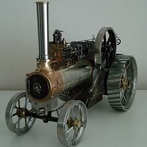Leaderboard
Popular Content
Showing content with the highest reputation on 01/30/2024 in all areas
-
1 point

Bits for my next Project
Cub Cadet reacted to Anglo Traction for a post in a topic
Not a lot of progress, what with the cold spell of the last 3 weeks. Confined myself in the warmer environment of the Lounge. Too cold in the workshop. Have been designing and drawing up the Fuel fittings I require. Nothing 'off the shelf' will suit, so making my own and using a 1950s ATCO Pet Cock as a guide. Got some Lathe time in over last few days and started turning up a Taper Reamer blank, then a first Pet Cock plug at the same settings. Got to produce several of these so I have a stock. The taper angle is 7 degrees inclusive . The little levers that screw into the plug are threaded 5/32" Whitworth, so making them the same - Had to keep to Imperial, not easy to mix metric on these, plus I have been asked to reproduce an old Pet Cock style for a restoration. Ready to part off the finished plug from the rod and make the next one now. The reamer blank is next to finish machining the cutting edges, then harden, temper and hone. Quite pleased really, as the new plug actually fits perfectly in the old tap body, so I got the angle right. Regards. -
1 point

Bits for my next Project
Cub Cadet reacted to Anglo Traction for a post in a topic
Thank you Gents for your positive comments. Lot of work sorting the Reduction Unit design set up. I needed to provide stanchions for the tank(s) support and location, bearing support for the fan drive, Pto clutch lever mount point and lubricator positions, all in one area. I decided on brass plates for extending up to fan shaft line. Started with an old 12 inch (305mm) square plate shown during marking out- After lot of cutting and careful drilling time, I was able to fit it and began the stiffening with bracing layout and fittng the welded and shaped stanchions. Lubrication connections made to fit into the large brass bearings, then made/fitted the mountings for the Lubricators. These Lubricators were found in an old barn in France about 15 years ago and are shown in the very first image of this Topic. Had to anneal the thick walled copper pipes, shaped to fit using a home made tube bender also shown in the image below- Had to use incompatible metals in this unit (electrolytic/galvanic reaction risk), so will have to be careful to seal the mating surfaces of the Aluminium and Brass parts, even though they will be polished and lacquered. Hoping to get this unit''s mounting plate/support welded up soon. Regards and wishing all a Happy New Year -
1 point

Bits for my next Project
Cub Cadet reacted to Anglo Traction for a post in a topic
Had some lathe and milling machine time in recently. Started on the wheel for the front caster. Had barely enough 40mm dia EN8 Steel to make the hub and leave enough for the drive coupling. Had to work really close to the chuck jaws, which was going fine with light feed, then I noticed the 'in-feed' movement of the parting tool went 'light' and easier !. I withdrew the tool and found it had failed !. As I bought it in a modestly priced set 38 years ago and just lightly stoned the cutting edge now and again, it has served me very well- I finished off with a narrow HSS type with no issues. Indexed and drilled for the spokes on the Mill with barely 1.5mm clearance between rotary table wheel and chuck ! - Also added an angled grease point and made the bronze bushes to be pressed in later- I decided to keep the original engine output drive clutch bell and make a driven plate to replace the original Mower Clutch plates to form a coupling. This would allow for any tiny misalignment of the engine and the reducton unit. The load transfered through this part will be much less than it was orignally handling in a Mower, but I wanted it to be efficient and reliable. Ordered a 105mm x 4mm laser cut mild Steel disc and meanwhile, I made 6 bronze wear pads - The slitting saw used is only 0.0125" (0.3mm) thick. These pads were soldered to the dog spokes of the plate where they will contact the recesses in the clutch bell. The plate was then set up to drill the 6 HT fixing screws to the boss- Once I had cut the keyway in the boss, I pressed the plate with the drilled and countersunk holes onto the boss and finished fitting the screws. i need to file out the keyway in the plate to depth. The bell drive recesses needed weld metal added where they were worn from mowing since 1954, but were not bad at all - The caster wheel is at the final assembly stage. My reasons for using surplus thick walled steel tubing for the rim left over from my previous Water Cart wheel making becomes clear. It all fits and allows me to re-use the wheel jig for accurate assembly ! - Regards
